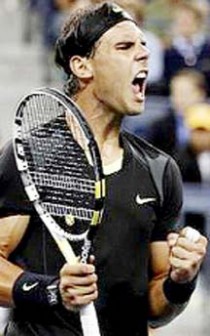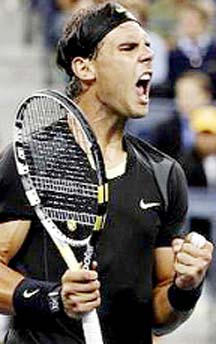PARIS, (Reuters) – A gaping hole on a smashed-up on-court bench bore testament to how maddening it is to play Rafa Nadal at Roland Garros as the Spaniard was hailed as the ‘greatest ever claycourt player’ after hoisting the French Open trophy for a record seventh time.
Novak Djokovic found plenty of uses for his racket during a soggy final which spilled into a second day yesterday. The world number one slammed it to the ground, sent debris flying everywhere after smashing it into his courtside bench and even whacked his head repeatedly with it.
But it simply could not conjure the strokes that would have allowed the Serb to become the first man in 43 years to win four grand slams in a row and instead Djokovic, with a sore head and tortured soul, fired a double fault that prompted Nadal to sink to his knees following a 6-4 6-3 2-6 7-5 victory.
The high-stakes showdown had started at 1517 local time on Sunday under menacing grey skies, was contested mainly through driving rain, and ended almost 23 hours later in a sudden burst of sunshine with a triumphant Nadal curled into a foetal position in the most famous arena in claycourt tennis.

On a court that has become a private stage for his jaw-dropping skills, Nadal eclipsed the record he shared with Bjorn Borg and showed the man who had defeated him in the last three grand slam finals that this was his stomping ground.
But unlike Borg, who quit the sport at 26, the same age as Nadal is now, the insatiable Spaniard still hungers to extend his astonishing Roland Garros run which now stands at 52-1, with a 7-0 record in the finals.
“He’s definitely best player in history on this surface, and results are showing that he’s one of the best-ever players that played this game,” Djokovic told reporters after his 27-match winning streak at the slams was ended by Nadal in the three hours 50 minute duel.
Nadal, though, was not feeling so invincible when he woke up yesterday morning with a 6-4 6-3 2-6 1-2 lead.
As far as he was concerned, the thought of joining Australian Jack Crawford as the only man to have lost four successive slam finals, was the stuff of nightmares.
“I had lost three grand slam finals in a row to him. If I had lost a fourth final, this would have been very difficult for me,” said Nadal, who had reached the Paris showpiece without dropping a set. “I was very nervous all night. So in my mind, this was the final I had to win.”
He need not have worried as after only 50 minutes of action on Monday, he was once again cradling the Musketeers’ Cup and running his fingers down the list of champions on the metal plate at the base of the trophy, knowing that as of June 11 2012, his name will appear on it more than anybody else’s.
EXCEPTIONAL ERA
Nadal might have rained down on Djokovic’s parade – denying him the chance of doing something no man has done since Australian great Rod Laver in 1969, but at least Djokovic had the consolation of knowing that he is an intrinsic part of an exceptional era in men’s tennis.
If there were any doubt about how this golden trio of Nadal, Djokovic and Roger Federer measure up to generations gone by, it seems that every time they step on a grand slam stage, there is a fresh deluge of eye-watering statistics.
They have now won 28 of the last 29 grand slams – it would have been 29-of-29 if Federer had not blown a two-sets-to-one lead against Juan Martin del Potro in the 2009 U.S. Open final.
All three players have been in a position to win four slams in row. Federer in 2006 and 2007, Nadal in 2011 and Djokovic this weekend. From 1969 to 2006, only Pete Sampras came close to pulling off the feat in the men’s game in 1994.
The trio have also dominated the top ranking since Federer first climbed to the summit in February 2004.

